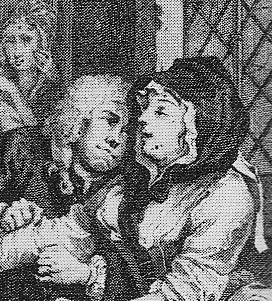
Monday and Wednesday 6:30-9:30
Art + Architecture Bldg. 2043
Gloeckner's e-mail
Gloeckner's web site
School of Art and Design
U of M
• SYLLABUS
• SEMESTER SCHEDULE
• STUDENT PROJECTS, winter 05
fall 04
• BORROW A COMIC
• PROJECT 1
• PROJECT 2
COMICS RESEARCH PROJECT
• ARTISTS
• THEMES
William Hogarth (1697-1764)
by Jessica Yurasek
Fall 2004
ARTIST LINK | MORE ARTISTS | COMICS-RELATED TOPICS
Born in London, England in 1697, William Hogarth is best known as a painter, engraver, and pictorial satirist. Originally apprentice to a silver-plate engraver, Ellis Gamble, Hogarth later began engraving on his own. By 1720 Hogarth had established his own business printing billheads, book illustrations and funeral tickets. He learned to paint at St. Martin's Lane Academy and then under Sir James Thornhill, whose daughter he married in 1729. After completing a number of portraits, in 1731 Hogarth completed his first series of modern morality paintings and shortly after, turned them into engravings. A Harlot's Progress (six scenes, destroyed by a fire) was followed by A Rake's Progress (eight scenes, located in London, Sir John Soane's Museum) and Marriage a la Mode (six scenes, located in London, National Gallery). These engravings quickly became popular. Hogarth's engravings were so popular in fact, that a number of people began to illegally copy his images in order to make a profit for themselves. Eventually, the stealing of his work led to the creation of the Copyright Act of 1735. Among other things, Hogarth ran his own academy for twenty years, helped establish a credible English school of painting, and published The Analysis of Beauty, a book stating that an artist has a better understanding of the arts than do connoisseurs.
Hogarth's 1731 engraving of A Harlot's Progress is about a young woman, Mary Hackabout, who arrives in London from the country. Presumably she has come to look for work as a servant, but a procuress praises her beauty and suggests a more profitable occupation: prostitution. Hogarth cleverly places visual clues and comments illuminating the story. Later, Hogarth publishes Marriage à la mode in 1745, depicting the upper class of 18th century society. Through these engravings based on paintings, Hogarth became famous for his ability to create satire relating to moral follies. His satire on marrying for money, upper-class life, and his ability to construct complex scenes made him famous. Hogarth's last work, The Bathos, was a farewell piece published in 1764. He died in England in 1764.

From The Harlot's Progress | more | Hogarth painting
On William Hogarth:
http://members.fortunecity.de/hogarth_scholar/Encyc.html
Links to Academic Resources on William Hogarth:
http://www.alllearn.org/er/tree.jsp?c=40535